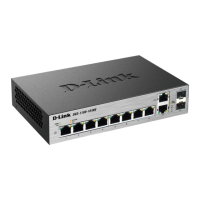Figure4.13 – Device Information
System > System Settings
The System Setting allows you to configure the IP address and the basic system information of the Switch.
IP Information: There are two ways for the switch to obtain an IP address: Static and DHCP (Dynamic Host
Configuration Protocol).
When using static mode, the IP Address, Subnet Mask, Gateway and DHCP Option 12 State can be
manually configured. When using DHCP mode, the Switch will first look for a DHCP server to provide it with
an IP address (including network mask and default gateway) before using the default or previously entered
settings. By default the IP setting is static mode with an IP address of 10.90.90.90 and subnet mask of
255.0.0.0.
System Information: By entering a System Name and System Location, the device can more easily be
recognized.
System Contact: By entering a system contact.
Login Timeout (3-30 minutes): The Login Timeout controls the idle time-out period for security purposes,
and when there is no action for a specific time span in the Web-based Management. If the current session
times out (expires), the user is required a re-login before using the Web-based Management again. Selective
range is from 3 to 30 minutes, and the default setting is 5 minutes.
Figure 4.14 – System > System Settings
System > DHCP Auto Configuration
From this page you can enable the DHCP Auto Configuration feature on the Switch. When enabled, the
Switch becomes a DHCP client and gets the configuration file from a TFTP server automatically on next boot
up. To accomplish this, the DHCP server must deliver the TFTP server IP address and configuration file

